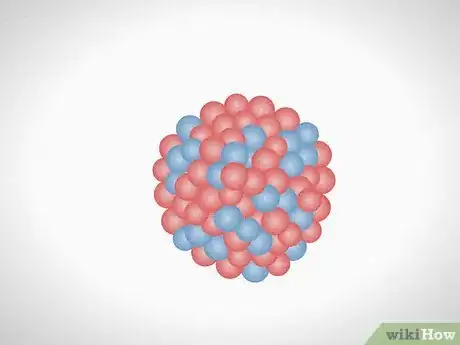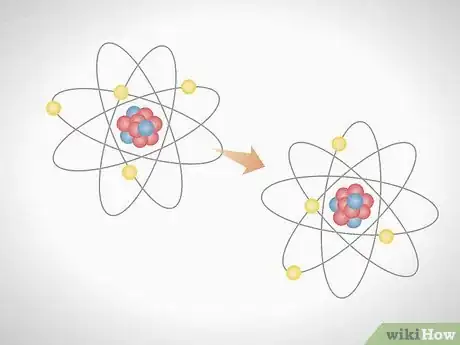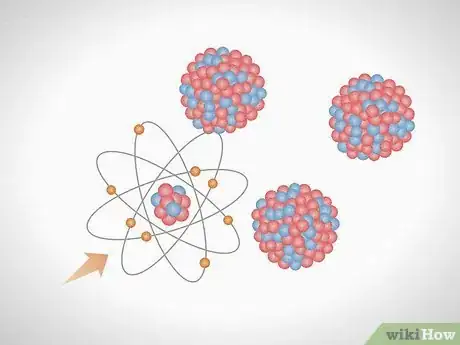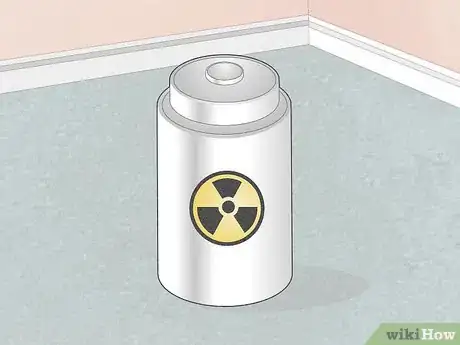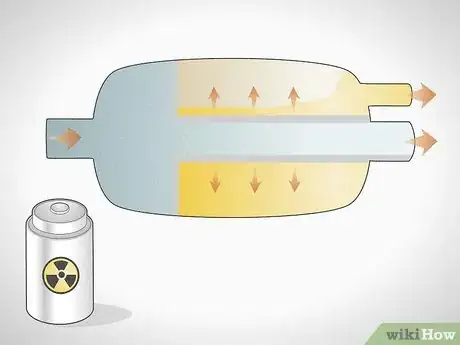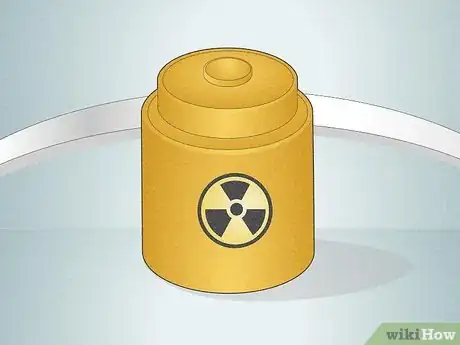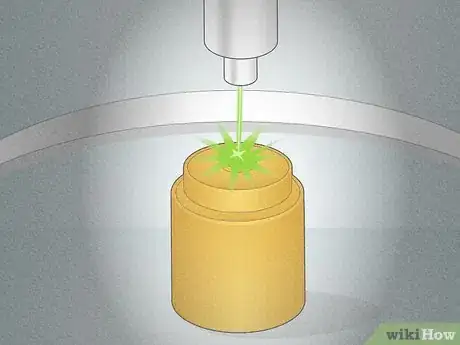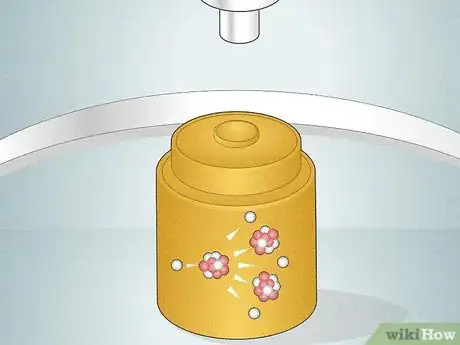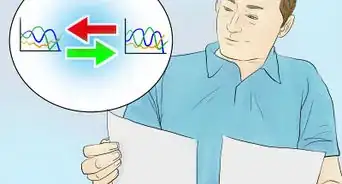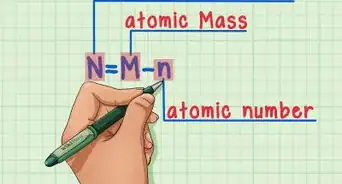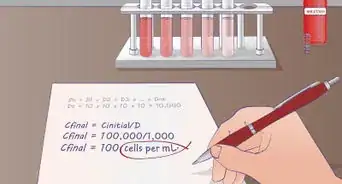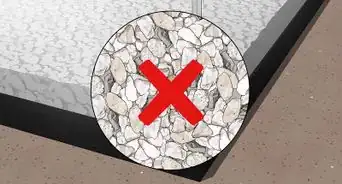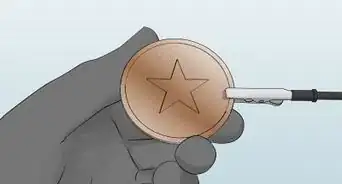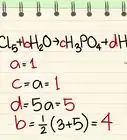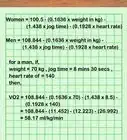This article was co-authored by Bess Ruff, MA. Bess Ruff is a Geography PhD student at Florida State University. She received her MA in Environmental Science and Management from the University of California, Santa Barbara in 2016. She has conducted survey work for marine spatial planning projects in the Caribbean and provided research support as a graduate fellow for the Sustainable Fisheries Group.
wikiHow marks an article as reader-approved once it receives enough positive feedback. In this case, 89% of readers who voted found the article helpful, earning it our reader-approved status.
This article has been viewed 194,713 times.
Atoms can gain or lose energy when an electron moves from a higher to a lower orbit around the nucleus. Splitting the nucleus of an atom, however, releases considerably more energy than that of an electron returning to a lower orbit from a higher one. Splitting an atom is called nuclear fission, and the repeated splitting of atoms in fission is called a chain reaction. Nuclear fission is carried out in power plants in order to create energy. Scientists split atoms in order to study atoms and the smaller parts they break into. This is not a process that can be carried out at home. You can only do nuclear fission in a laboratory or nuclear plant that is properly equipped.
Things You Should Know
- Splitting the nucleus of an atom releases energy.
- When many atoms are split, it can lead to a chain reaction, which releases a lot of energy in the form of a massive explosion.
- The process of splitting atoms is called nuclear fission.
Steps
Bombarding Radioactive Isotopes
-
1Choose the right isotope. Not all isotopes are created equal when it comes to being readily split. The most common isotope of uranium has an atomic weight of 238, consisting of 92 protons and 146 neutrons, but these nuclei tend to absorb neutrons without being split into smaller nuclei of other elements. An isotope of uranium with 3 fewer neutrons, 235U, can much more readily be split apart than can 238U; such an isotope is called fissile.[1]
- When uranium splits (undergoes fission) it releases 3 neutrons that collide with other uranium atoms, thus creating a chain reaction.
- Some isotopes can be split too readily, so fast that a continuous fission reaction can’t be maintained. This is called spontaneous fission; the plutonium isotope 240Pu is such an isotope, unlike the isotope 239Pu with its slower fission rate.
-
2Get enough of the isotope to ensure fission will continue after the first atom is split. This requires having a certain minimum amount of the fissile isotope to make the fission reaction sustainable; this is called critical mass. Achieving critical mass requires enough of source material for the isotope to increase the chances of fission occurring.[2]Advertisement
-
3Fire one atomic nucleus of the same isotope at another. Because loose subatomic particles are difficult to come by, it’s often necessary to force them out of the atoms they’re part of. One method of doing this is firing atoms of a given isotope against other atoms of that same isotope.[3]
- This method was used to create the 235U atomic bomb dropped on Hiroshima. A gun-like weapon with a uranium core fired 235U atoms at another piece of 235U-bearing material fast enough to have the neutrons they released naturally slam into the nuclei of other 235U atoms and break them apart. The neutrons released when the atoms split would, in turn, strike and split other 235U atoms. The end result was a massive explosion.
-
4Bombard the nuclei of the fissile isotope with subatomic particles. A single subatomic particle can strike an atom of 235U, splitting it into 2 separate atoms of other elements and releasing 3 neutrons. These particles can come from a moderated source (e.g. a neutron gun) or can be generated when nuclei collide. Three types of subatomic particles are commonly used.[4]
- Protons. These subatomic particles have mass and a positive charge. The number of protons in an atom determines what element the atom is.
- Neutrons. These subatomic particles have the mass as protons but no charge.
- Alpha particles. These particles are the nuclei of helium atoms, shorn of their orbiting electrons. They consist of 2 protons and 2 neutrons.
Compressing Radioactive Materials
-
1Obtain a critical mass of a radioactive isotope. You will need enough raw material to make sure that fission continues. Keep in mind that in a given sample of some element (plutonium for example), you will have more than 1 isotope. Make sure that you have calculated how much of the desired fissile isotope is in your sample.[5]
-
2Enrich the isotope. Sometimes, it is necessary to increase the relative amount of fissile isotope in a sample to ensure a sustainable fission reaction occurs. This is called enrichment. There are several ways to enrich radioactive materials. Some of these are:[6]
- Gas Diffusion
- Centrifuge
- Electromagnetic Separation
- Liquid Thermal Diffusion
-
3Squeeze the atomic sample tight, bringing fissile atoms closer together. Sometimes, atoms decay too fast on their own to be fired at one another. In this case, bringing the atoms closer together increases the chance of released subatomic particles striking and splitting other atoms. This can be done by using explosives to force the fissile atoms close together.239Pu atoms.[7]
- This method was used to create the 239Pu atomic bomb dropped on Nagasaki. Conventional explosives ringed a mass of plutonium; when detonated, they pushed the plutonium mass together, bringing the 239Pu atoms close enough together that the neutrons they released would continuously strike and split other plutonium atoms. This created an enormous explosion.
Splitting Atoms with a Laser
-
1Encase radioactive materials in metal. Place your radioactive material in a gold casing. Use a copper holder to fasten the casing into place. Keep in mind that both the fissile and the metals will become radioactive once fission takes place.[8]
-
2Excite electrons with laser light. With the development of petawatt (1015 watt) lasers, it is now possible to split atoms by using laser light to excite electrons in metals encasing a radioactive substance. Similarly, you could use a 50 terawatt (5 x 1012 watt) laser to excite the electrons in the metal.[9]
-
3Stop the laser. When the electrons return to their regular orbits, they release high-energy gamma radiation that penetrates the gold and copper nuclei. This will liberate neutrons from those nuclei. Those neutrons will then collide with the uranium underneath the gold splitting the uranium atoms. [10]
Community Q&A
-
QuestionCan a human be split into particles like an atom?
 Community AnswerI suppose being hit directly by something like a nuclear bomb could take a person apart on a sub-atomic level. So, yes, but it would take immense power.
Community AnswerI suppose being hit directly by something like a nuclear bomb could take a person apart on a sub-atomic level. So, yes, but it would take immense power. -
QuestionIf you put a a uranium 235 atom in a copper wire and add current, will the stream of electrons split the uranium atom?
 Community AnswerIt is most likely that the electrons will just be stripped of the uranium 235 atoms and it will conduct the electricity, as it is a conductor.
Community AnswerIt is most likely that the electrons will just be stripped of the uranium 235 atoms and it will conduct the electricity, as it is a conductor. -
QuestionCan I buy an atom splitting kit at the hobby store?
 Community AnswerUnfortunately, you can't. Even if you could, it would be very expensive. Also, splitting an atom is very dangerous, and not recommended to do at home.
Community AnswerUnfortunately, you can't. Even if you could, it would be very expensive. Also, splitting an atom is very dangerous, and not recommended to do at home.
Warnings
- This process could lead to a massive explosion.⧼thumbs_response⧽
- Doing this on your own is illegal. Do this only a proper facility such as a nuclear power plant or physics lab.⧼thumbs_response⧽
- Radiation can kill you. Wear proper safety gear. Maintain a safe distance from radioactive materials.⧼thumbs_response⧽
- As with any equipment, follow the required safety procedures, and don't do anything that seems risky.⧼thumbs_response⧽
References
- ↑ http://www.physics4kids.com/files/mod_fission.html
- ↑ http://www.physics4kids.com/files/mod_fission.html
- ↑ http://www.atomicheritage.org/history/science-behind-atom-bomb
- ↑ http://www.physics4kids.com/files/mod_fission.html
- ↑ http://www.atomicheritage.org/history/science-behind-atom-bomb
- ↑ http://www.atomicheritage.org/history/science-behind-atom-bomb
- ↑ http://www.atomicheritage.org/history/science-behind-atom-bomb
- ↑ http://physics.aps.org/story/v5/st3
- ↑ http://physics.aps.org/story/v5/st3
About This Article
There are 3 ways to split an atom, which is also known as creating nuclear fission. For the first, you’ll need to bombard a radioactive isotope that’s easily splittable, like Uranium-235, with subatomic particles like protons or neutrons. You can also split an atom by compressing a critical mass of radioactive atoms, bringing them so close together that their subatomic particles will strike each other. If you want to learn how to split atoms using a laser, keep reading the article!
